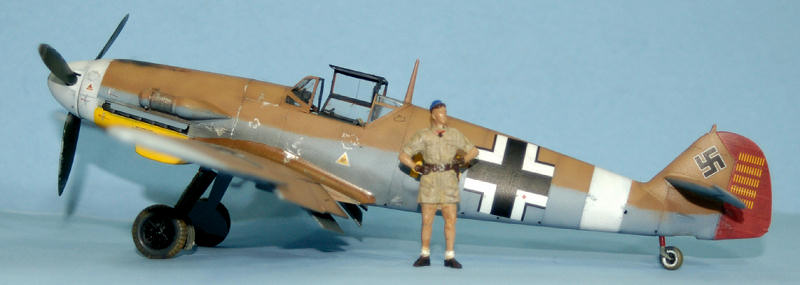
Hasegawa 1/32 Bf-109F-4
| KIT #: | 08881 |
| PRICE: | 4600 yen from www.hlj.com |
| DECALS: | Three options |
| REVIEWER: | Tom Cleaver |
| NOTES: | Includes Marseille figure |

| HISTORY |
Shortly after the
introduction of the Bf-109E into service,
Messerschmitt proceeded to design a major improvement to
the Bf 109. The new model was included structural and aerodynamic changes to
take maximum advantage of a higher performance powerplant, the 1,350 horsepower
DB 601E.
Inserting the radiators deeper in the wings reduced drag and improved
lift. The engine cowling was streamlined with an enlarged spinner with the
propeller blades widened and shortened, while the wingtips were rounded and
shorter-span ailerons were introduced, and the tail plane bracing struts were
removed. The V‑21, V‑22, V‑23, and V‑24 prototypes tested early versions of the
DB 601E engine, the new wings, and other changes.
Armament was standardized on two fuselage-mounted 7.9mm machine guns and
a 15mm or 20mm cannon firing through the propeller shaft, based on combat
reports that the concentrated firepower of the fuselage guns was more effective
than the converging bullet streams from the wing guns on the Bf-109E.
Without the heavy
cannons in the wings, handling characteristics were greatly improved.
The wings were always the weak point of the Bf-109
design, and removing the guns allowed greater high-G maneuvering without fear of
wing failure that had been found in the Bf-109E.
When it was introduced to combat, the Bf-109F
demonstrated superiority to the new Spitfire V just being issued to RAF Fighter
Command.
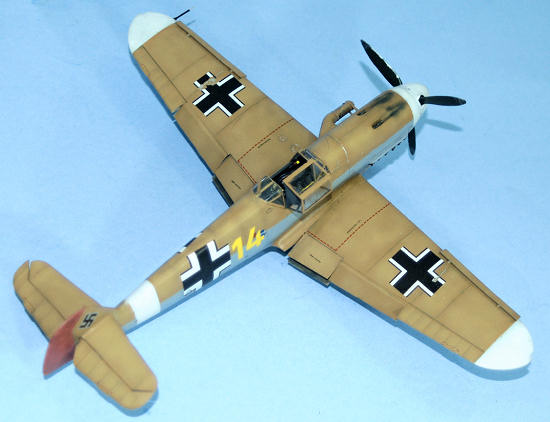 While
Werner Molders advocated this new armament, Adolf Galland argued it was a
retrograde step, that the average Luftwaffe pilot needed the increased weight of
fire of the 20mm wing guns to give the margin of victory.
Galland was so adamant on this point that he continued
to fly his Bf-109E-4/N even after being given a Bf-109F-0, and did not fully
adopt the Friedrich until Messerschmitt
provided him two Bf-109F-2/S one-off specials - one with 13mm fuselage weapons
and one with internally-mounted 20mm wing guns - which he used through the
second half of 1941 while he continued to command JG 26.
While
Werner Molders advocated this new armament, Adolf Galland argued it was a
retrograde step, that the average Luftwaffe pilot needed the increased weight of
fire of the 20mm wing guns to give the margin of victory.
Galland was so adamant on this point that he continued
to fly his Bf-109E-4/N even after being given a Bf-109F-0, and did not fully
adopt the Friedrich until Messerschmitt
provided him two Bf-109F-2/S one-off specials - one with 13mm fuselage weapons
and one with internally-mounted 20mm wing guns - which he used through the
second half of 1941 while he continued to command JG 26.
Due to delays in
production of the 601E, delivery of the Bf 109F‑0 and Bf-109F-1, began in
November 1940 with the aircraft still powered by the DB 601N engine used in the
Bf-109E-4 and E-7 and utilizing the MG-FF 20mm cannon.
Soon after their introduction, Luftwaffe units reported
unexplained losses, following violent vibrations and loss of control.
Examination of wreckage revealed that removing the tail
bracing struts without additionally strengthening the fuselage had caused the
problem; this was remedied by fitting reinforcing plates on the fuselage. The Bf
109F‑2, introduced in February 1941 differed from the F‑1 with the introduction
of the MG 151 15mm cannon.
In early 1942, the DB 601E was finally installed in the
Bf-109F‑3 and the Bf-109F‑4.
The F‑3 continued use of the 15mm MG 151l like the F‑2,
while the F‑4 introduced a larger MG 151 20mm cannon, self‑sealing fuel tanks,
and better pilot armor.
The Bf-109F‑4 was
the ultimate Friedrich.; Weighing 6,880
pounds, it had a top speed of 390 m.p.h. at 20,000 feet, with a service ceiling
of 39,400 feet.
The Bf-109F‑4/R6, introduced at the insistence of Adolph Galland
after he became General der Jagdflieger,
carried a pair of MG 151s in underwing gondolas.
Handling was adversely affected and the R6 was limited
to bomber interceptor roles.
The final version was the Bf-109F‑4/Trop, modified for
use in North Africa.
Just over 2,000 Bf-109Fs were produced - 16% of the total Bf-109
production - before being replaced by the 109G.
On the Channel
Front, the Bf-109F allowed the Luftwaffe to maintain air superiority over the
RAF even with only two Jagdgeschwadern
- JG 2 and JG 26 - committed to the battle.
In North Africa, the Bf-109F was superior to every RAF
fighter it opposed, and only the increasing numerical superiority of the Allies
in North Africa was able to eventually overcome this superiority.
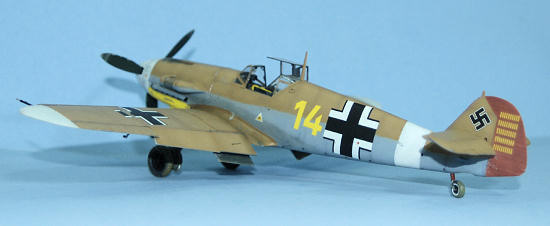
With Neumann giving
him the kind of support he needed, and with the lack of “social alternatives” in
the desert,
Marseille began to analyze his combat activity, began a personal
program to improve his abilities as a fighter pilot.
He also worked to
strengthen his abdominal and leg muscles to enhance his ability to sustain
higher G‑Forces for longer durations during dogfights than the average fighter
pilot.
He also took every opportunity to perform breathtaking
aerobatics. In addition to providing entertainment to his friends, these
exercises also gave him outstanding control and confidence in performing extreme
maneuvers.
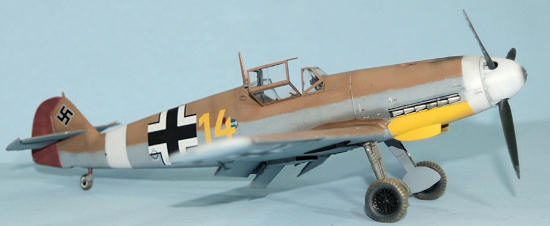 to
make high-angle deflection shots from short range while in a sharp turn.
He never used his gunsight, instead firing a very short
burst at the passing target in the split second when its propeller disappeared
behind his aircraft's nose. He calculated that with a short burst at this
position, the rounds would hit the target's engine and cockpit.
He concluded that, over the desert, a fighter pilot can
become "invisible" only by in extreme maneuvers at close range, and that the
intensity of the maneuvering was more important than speed.
to
make high-angle deflection shots from short range while in a sharp turn.
He never used his gunsight, instead firing a very short
burst at the passing target in the split second when its propeller disappeared
behind his aircraft's nose. He calculated that with a short burst at this
position, the rounds would hit the target's engine and cockpit.
He concluded that, over the desert, a fighter pilot can
become "invisible" only by in extreme maneuvers at close range, and that the
intensity of the maneuvering was more important than speed.
Marseille first
demonstrated his new abilities on Sept. 24, 1941.
On a fighter sweep, he suddenly broke formation and flew
off in a direction where no one else saw anything. When his fellow pilots caught
up with him, he had already shot down a bomber. Later the same day, his
formation of six met 16 Hurricanes.
As a junior pilot, Marseille and his wingman were
ordered to provide cover to the other four, which attacked the Hurricanes.
After three Hurricanes were shot down, Marseille told
his wingman to cover him and attacked a formation of four Hurricanes passing
below. He dove, leveled at their altitude, and shot down two in a single burst
while in a sharp turn. He then dove to gain airspeed then zoomed back up and
shot down a third Hurricane.
The two formations then disengaged.
Marseille climbed to a higher altitude, then dove on
retreating Hurricanes and shot down a fourth, his fifth victory of the day.
On his return to base, he told a friend, "I believe now
I have got it."
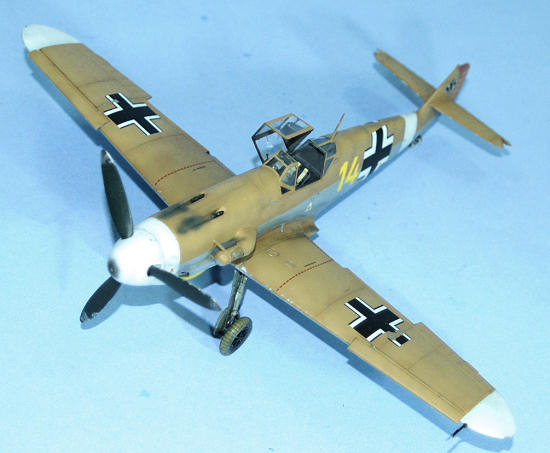
Posthumously, Marseille was awarded the Diamonds to the Knights Cross, in addition to the Oak Leaves and Swords he had been awarded previously. On his grave, his squadron mates put his name and rank, and one word: “Undefeated.”
| THE KIT |
Modelers have been
waiting for Hasegawa to do a Bf-109F since the first Bf-109G kit was released
way back in 2003.
Many have stared at the upper cowling part in the
Bf-109G-4 kit, with the sprue labeled “BF109F” and wondered to themselves how
long it would be.
In 2007, Bf-109 fans were happy to pick up the Bf-109F
kit released by 21st Century Toys,
which was as close it seemed as anyone was going to get to a
Friedrich in 1/32 scale.
Hasegawa has finally
released the first of what is bound to be at least two different Bf-109F
sub-types, the popular Bf-109F-4/Trop.
It is obvious they have done their homework.
The spinner has finally been re-done in the correct
shape.
There are separate sprues for the correct “narrow” paddle-blade props of
the F-4 sub-type.
Additionally, different canopy windscreens and a
different tail wheel, along with a separate sprue for the oil cooler, and
another separate sprue for the supercharger intake and the left cowling, point
to the imminent arrival of a Bf-109F-2.
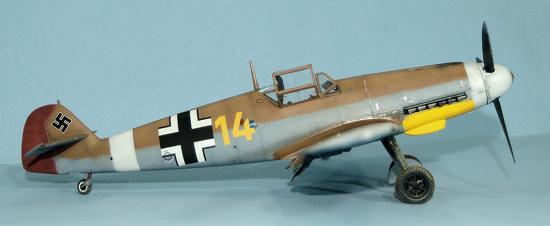 One of the
nicest things Hasegawa had done is to mold the fuselage in one piece, with the
tail no longer separate. While they had designed the separate tail in such a way
that it was virtually fool-proof to assemble correctly, this insures things are
right.
This fuselage also has all the G-model panels changed, with the proper
gas filler below the cockpit, and other small but important details catered to.
The cockpit detail is correct for the F-version and
quite different from the later G sub-types, and includes both kinds of separate
seats used by the Friedrich.
One of the
nicest things Hasegawa had done is to mold the fuselage in one piece, with the
tail no longer separate. While they had designed the separate tail in such a way
that it was virtually fool-proof to assemble correctly, this insures things are
right.
This fuselage also has all the G-model panels changed, with the proper
gas filler below the cockpit, and other small but important details catered to.
The cockpit detail is correct for the F-version and
quite different from the later G sub-types, and includes both kinds of separate
seats used by the Friedrich.
Decals are for the four Bf-109F-4/Trop aircraft flown by Hans Joachim
Marseille during his career with JG 27.
Those who get the
initial release of this kit will also receive a very nice resin figure of
Marseille, done from a well-known photograph.
The figure's face is recognizably Marseille's.
While some modelers have complained about a very high price for this kit, and pointed fingers at Hasegawa for raising prices, the actual fact is that the recent price increases are entirely due to the fact that the US dollar has dropped against the Yen from around 100:1 to 80:1. HobbyLink Japan has done their best to present this initial kit at the old price, and is charging the Yen equivalent of US$56.00 which is indeed very reasonable.
| CONSTRUCTION |
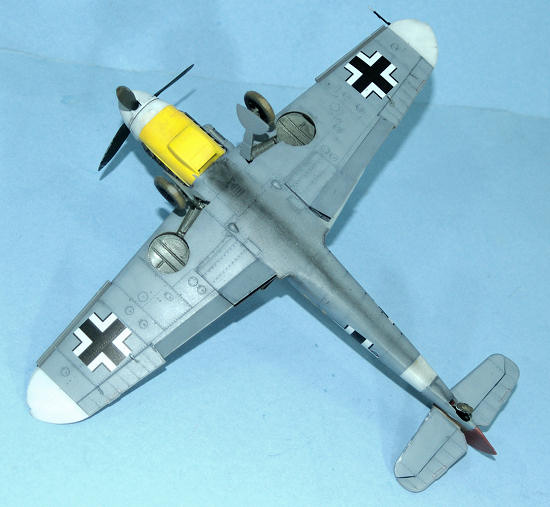 Hey, it's
a Hasegawa 109, the closet thing to an idiot-proof kit ever designed.
Follow the instructions and there are no problems.
Everything fits the way it's supposed to.
Hey, it's
a Hasegawa 109, the closet thing to an idiot-proof kit ever designed.
Follow the instructions and there are no problems.
Everything fits the way it's supposed to.
My only deviations
from an out-of-box project were to cut off the elevators and pose them “drooped”
(with the control stick modified to sit appropriately in the cockpit) and to use
an Eduard photoetch Luftwaffe seat belt.
Hasegawa provides some decal seat belts that look
nothing like any German seatbelts I have ever seen.
I used the instrument panel decal, which needs to be
sliced and then hit with solvent a second time after it sets up, to be sure it
gets down in the panel properly.
I liked the fact
that two different seats are provided.
“Mister 109,” Lynn Ritger, told me that the seat that is
kind of like a 109E seat is correct for Marseille's first airplane, which is the
one I wanted to do.
One pain in the neck is the separate exhausts. The old single-piece exhausts were just fine for me on the earlier kits, and this is the one place where the kit is not completely “idiot-proof.”
| COLORS AND MARKINGS |
Painting:
I painted the white
ID markings and masked them off, then painted the yellow theater ID marking and
masked it, then painted the rudder a brick-red color that matched the decal the
kit provides.
I then pre-shaded the model with Tamiya “German Grey.”
The model was then painted with Xtracrylix RLM 79
Sandgelb and RLM 78
Hellblau.
I “sun faded” the upper surfaces by adding in a little
light grey and making a pass, then a little yellow and making a pass, then
adding in white and doing the wing and horizontal stabilizer and the upper areas
of the fuselage spine.
The end result is nice and subtle, and looks like it's
been in the desert awhile.
Decals:
I used the kit decals to make Marseille's first “Gelbe Vierzehn” that he flew for his first 50 victories. These decals seemed a bit thick, and I had to give them several coats of Micro-sol and then hit them twice with Solvaset to get them to settle in completely.
| FINAL BITS |
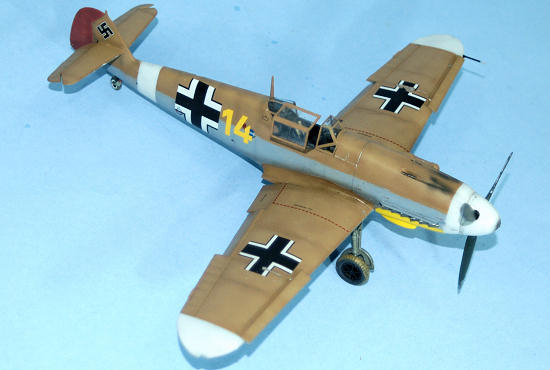 I first
gave the model several coats of Xtracrylix “Flat Varnish” to get a flat
sun-faded look.
Since this airplane would have been “dinged” as it operated from
unprepared open desert fields, I dinged the leading edges of the flying
surfaces, as well as the prop, making sure to “sandblast” the prop tips, all
done with Tamiya “Flat Aluminum”.
I then applied exhaust and oil stains with Tamiya
“Smoke” and the gunshot residue with thinned Tamiya NATO Black.”
I also “muddied” the wheels.
I first
gave the model several coats of Xtracrylix “Flat Varnish” to get a flat
sun-faded look.
Since this airplane would have been “dinged” as it operated from
unprepared open desert fields, I dinged the leading edges of the flying
surfaces, as well as the prop, making sure to “sandblast” the prop tips, all
done with Tamiya “Flat Aluminum”.
I then applied exhaust and oil stains with Tamiya
“Smoke” and the gunshot residue with thinned Tamiya NATO Black.”
I also “muddied” the wheels.
I then unmasked the canopy and attached it in the open position, and
attached the exhausts and the prop.
The figure:
The figure was
painted by airbrushing Gunze-Sangyo “Sail Color” overall. I painted the arms,
legs and face with Xtracrylix “Sandgelb” lightened with white to simulate
tanning, and painted the belt, boots, and pistol holster with Xtracrylix RLM 61
Dunkelbraun. I “popped out” detail with
a light coat of Tamiya “Smoke”, then gave the figure a coat of Xtracrylix Clear
Flat varnish.
| CONCLUSIONS |
Highly recommended.
Review kit courtesy
of HobbyLink Japan.
Get yours at:
October 2010
If you would like your product reviewed fairly and quickly, please contact me or see other details in the Note to Contributors.